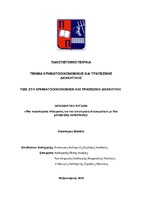Μια προσέγγιση πλέγματος για την αποτίμηση δικαιωμάτων με δύο μεταβλητές κατάστασης
A lattice approach for option pricing with two state variables

View/
Keywords
Μοντέλο Kamrad & Ritchken ; Μοντέλο Stulz ; Δικαίωμα προαίρεσης ; Μία μεταβλητή κατάστασης ; Μοντέλο Boyle ; Αλγόριθμος Levenberg - Marquardt ; Δύο μεταβλητές κατάστασης ; Εκτίμηση παραμέτρων ; Προβλεπτική ικανότητα ; Αριθμητική ανάλυσηAbstract
This thesis refers to the valuation of options via a lattice approach when there are two underlying state variables. More specifically, the case where the payoff of the option is a function (maximum & minimum) of two underlying state variables is examined. Initially, the options and their characteristics are described in general and we also provide a historical review of options’ valuation with two state variables. Then the lattice models of Cox-Ross-Rubinstein (1979), Boyle (1988) and Kamrad & Ritchken (1991) for valuation of options with one state variable are presented, followed by the extension of the Black & Scholes (1973) model as well as of the aforementioned lattice models (Boyle, Kamrad & Ritchken) for valuation of options with two state variables.
Empirical study and numerical analysis is also performed using the MATLAB programming language for the lattice models of Boyle (1988) and Kamrad & Ritchken (1991) for one and two state variables, respectively. After evaluating the parameters of the models with the Levenberg - Marquardt iterative algorithm and checking their predictive ability, we conclude that the Kamrad & Ritchken (1991) lattice model is a reliable model for valuation of options with two state variables.


